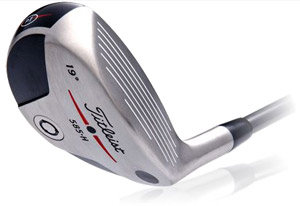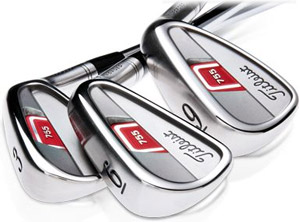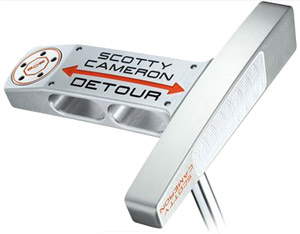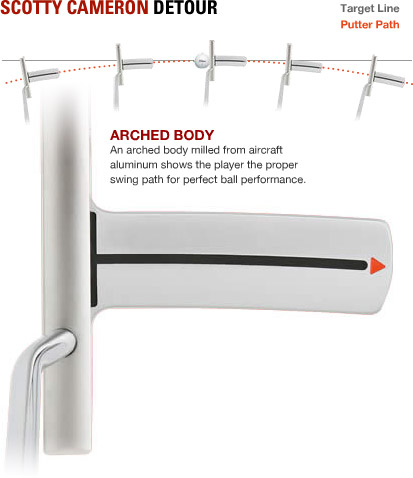 I’ve never understood the rationale for launching new equipment in the fall. Is it to boost sales in the fourth quarter? Is it to give off-course shops a holiday season shot in the arm? Or is it to force pros in northern climes to add inventory just as they’re trying to clear the shop for winter?
I’ve never understood the rationale for launching new equipment in the fall. Is it to boost sales in the fourth quarter? Is it to give off-course shops a holiday season shot in the arm? Or is it to force pros in northern climes to add inventory just as they’re trying to clear the shop for winter?
It just seems that ever since the big boys (Titleist, Callaway, TaylorMade) decided to opt out of the January PGA Merchandise Show in Orlando, new product launches come in barrages in the spring and fall. So be it in this new age of club marketing.
Anyway, on to the latest… after teasing us for some months now as their staff pros put the goods to use on the various tours, Titleist is releasing new fairway clubs, hybrids, irons, and a new Scotty Cameron putter. Read on for a quick rundown on what to expect when they officially hit the market on August 15.
 Sales of Titleist clubs were off significantly in the second quarter this year with net sales down $17.7 million against the second quarter 2005. Analysts say Titleist’s narrow focus on the premium market and the heavy discounts and promotions from competitors this year were contributing factors.
Sales of Titleist clubs were off significantly in the second quarter this year with net sales down $17.7 million against the second quarter 2005. Analysts say Titleist’s narrow focus on the premium market and the heavy discounts and promotions from competitors this year were contributing factors.
They also say this fall’s new product introductions should give the company a significant increase in sales. Hmmmmm. Maybe that’s one reason for fall product launches.
We’ll be reviewing all of these new clubs in great detail after we’ve had a chance to play with them. In the meantime, though, here’s what you can expect when they show up soon in a shop near you.
PT 906F2 Fairway Metals
As someone who has long struggled to find fairway clubs without a hook face, these clubs look very good indeed. But the big news, according to Titleist, is the new “Multi-Relief” sole.
 This new sole design is supposed to minimize turf resistant and keep contact with the ground toward the leading edge of the sole so the club doesn’t bounce or skip through impact. This means these clubs should be very good from tight lies in closely mown fairways and for players who tend to sweep the ball with a shallow angle of attack.
This new sole design is supposed to minimize turf resistant and keep contact with the ground toward the leading edge of the sole so the club doesn’t bounce or skip through impact. This means these clubs should be very good from tight lies in closely mown fairways and for players who tend to sweep the ball with a shallow angle of attack.
As opposed to the current trend of moving the center of gravity further from the face to promote higher launch, Titleist has moved it closer to the face. This delivers less draw bias and a more neutral flight so good players can better shape their shots.
The heads are fashioned from a softer stainless steel to deliver a solid feel while the face is made of the harder 275 Carpenter steel. The face is also larger than on previous models to deliver some degree of forgiveness.
Cosmetically, black is the new grey. While the clubs continue such hallowed Titleist touches as bore-through shafts, pear-shaped heads, and triangle alignment graphics, they now come in a gloss black that extends even onto the sole. It’s definitely a new look for Titleist.
The PT 906F2 (PT = “Pro Trajectory”) fairway metals come in three lofts: 13°, 15°, and 18°. Stock shafts include Aldila NV 75, UST Proforce V2 85, and Titleist 4375. The stock grip is Golf Pride Tour Velvet. Suggested retail price is $200 in steel, $250 in graphite.
PT 585.H Utility Metals
Utility clubs started out as crutches for codgers like me who lost (or never had) the ability to hit long irons. With this new line, however, Titleist delivers the first utilities that, to me, look like player’s clubs.
 For starters, there’s no offset. Remarkable! And the lack of offset looks very good coupled with the compact teardrop-shaped head. With no offset and a perfectly square face, the clubs deliver a neutral bias and a lower peak trajectory so, like the new fairway metals, a skilled player can better shape shots.
For starters, there’s no offset. Remarkable! And the lack of offset looks very good coupled with the compact teardrop-shaped head. With no offset and a perfectly square face, the clubs deliver a neutral bias and a lower peak trajectory so, like the new fairway metals, a skilled player can better shape shots.
At the same time, the new design does help get the ball in the air with a 20-gram tungsten weight back in the sole to get the center of gravity low. There’s also a modified bore-through shaft design with a polymer pin to enhance sound and feel.
Like the fairway metals, the utilities are made with a softer stainless steel body but with a harder 455 stainless steel face insert. The sole is a simple contoured shape that should help it in dealing with a variety of lies… good and bad.
These clubs also feature the new gloss black paint scheme. And while I know they didn’t paint the hosel to give the club that funky utility look, I think painting it would have better reinforced the optical advantage of the square face. But that’s just me.
The PT 585.H Utility Metals are available in four lofts: 17°, 19°, 21°, and 24°. Stock shafts include Dynamic Golf S300 for fans of steel and the Aldila NV 85 and Titleist 4175 for graphite users. Tour Velvet grips are standard. Suggested retail price is $175 for steel and $208 for graphite.
755 Forged Cavity Back Irons
Ever since Ping and their Eye 2 irons, there’s been a place on the PGA Tour and in the bags of better players for cavity-back irons. With the introduction of their 755 model, Titleist further refines this form with a forged stainless steel iron with an ultra-thin face and dramatic heel and toe weighting.
 With this new design, Titleist redistributes 10 grams of weight away from the face for a higher moment of inertia and greater clubhead stability. Filling in the gap in the back is a red vibration-dampening chip to help enhance sound and feel. I’ve heard mixed reactions to the color choice, but I like it.
With this new design, Titleist redistributes 10 grams of weight away from the face for a higher moment of inertia and greater clubhead stability. Filling in the gap in the back is a red vibration-dampening chip to help enhance sound and feel. I’ve heard mixed reactions to the color choice, but I like it.
As is now somewhat common in clubs of this ilk, progressive offset decreases from the long irons through the short irons. What is unique, however, is that the hosels of the 2- through 7-irons are shorter than they are in the 8-iron through pitching wedge. According to Titleist, this helps launch conditions in the longer irons and delivers better knock down capabilities in the short irons.
The 410 stainless steel head comes with a non-glare satin finish and while the material is nowhere near as soft as the carbon steel in Titleist’s blades, the thin face and polymer chip should deliver a softer fee.
In the playing position, they are very good looking club. I can’t help but be reminded of the old DCI irons when I look at the pictures. There must be some sort of genetic thread happening with Titleist irons.
The 755 irons are available in both left- and right-handed versions, although the left-handed 2-iron is a special order. The stock shaft is a Titleist Tri-Spec in regular and stiff flexes. Tour Velvets are the factory grips. Suggested retail is $112 per iron in steel ($899 per set), $129 per iron in graphite ($999 per set).
Scotty Cameron Detour Putter
While his detractors say that Scotty Cameron has built his reputation co-opting the designs of others, including Karsten Solheim and T.P. Mills, I disagree. While he has based most of his putters on the classic shapes of his industry, he has consistently improved them in substantive ways both dramatic (perfectly milled heads in a variety of materials) and subtle (such as the different looks of the Newport and Newport 2).
 And he has also proven himself a genuine innovator; the Futura and Phantom lines server as chief examples. Now, with the introduction of the Detour, he has really cemented his reputation for new ideas because this truly is one revolutionary putter.
And he has also proven himself a genuine innovator; the Futura and Phantom lines server as chief examples. Now, with the introduction of the Detour, he has really cemented his reputation for new ideas because this truly is one revolutionary putter.
Cameron is a proponent of the inside-square-inside putting stroke that follows a natural arc, much like a swinging gate. It’s the same concept Stan Utley has become famous for teaching.
The Detour putter is the first putter ever to present a visual cue for this stroke. The body and sight line are slightly curved along the arc, and that curve is evident at address. It’s truly a unique idea.
But it isn’t just the look that helps the stroke. The design of the putter positions weight to enhance the “closing door” nature of the stroke. Lightweight aircraft aluminum is milled to form a one-piece body and face insert. The blade-like face surrounding the insert is heavier milled stainless steel to provide extreme heel-toe weighting.
A milled toe-pocket with an aluminum counterweight further insures proper sweet spot location. And a stainless steel backweight with a vibration-dampening ring helps with sound and feel.

Cameron has also borrowed a couple design notes from previous putters. Like the Circa 62 line introduced earlier this year, the Detour has a high angled toe to provide a better look at address. And, similar to the Red X and Studio Style lines, there is an elastomer gasket around the insert to further enhance feel.
The putter comes in two versions. The Detour features a single bend shaft with offset while the Detour 2 has a straight shaft. Both are available in 34- and 35-inch lengths while lefthanders only have the Detour to choose. Righties can special order a 33″ version. The grip is a black Baby T. Typical of Cameron putters, suggested retail is a whopping $299.
The putter is already shown up on the PGA Tour with Dudley Hart and Jeff Sluman, among others, putting it into play. Our Editor, Erik J. Barzeski, has even posted his thoughts on the Detour and other clubs in our forum.
In the End…
Titleist isn’t bashful about targeting better players with its clubs. It’s a strategy that has given them a top-line reputation for years now as they differentiate and play off their excellent Cobra brand of value-priced clubs. The fall 2006 lineup of new clubs does nothing to change that. These are excellent clubs for excellent players.